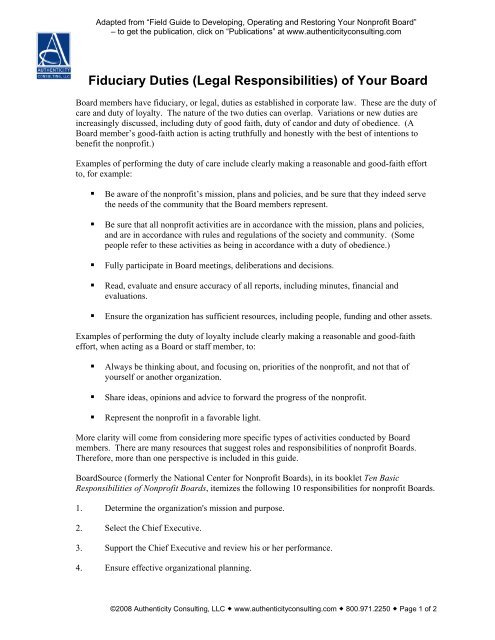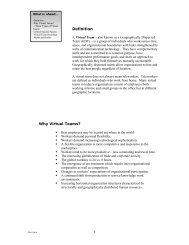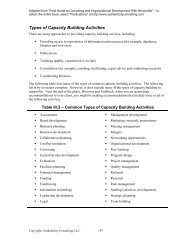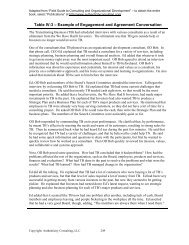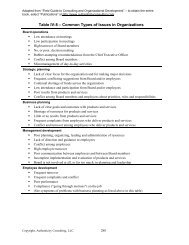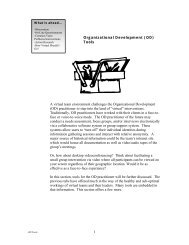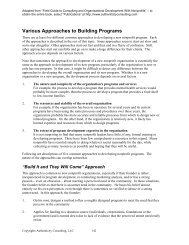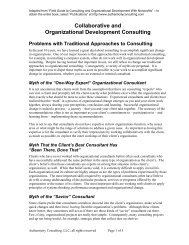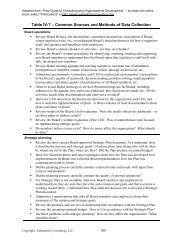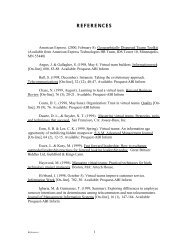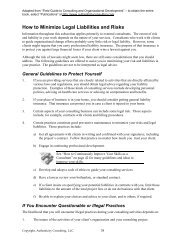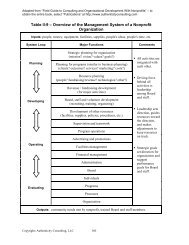Fiduciary Duties (Legal Responsibilities) of Your Board
Fiduciary Duties (Legal Responsibilities) of Your Board
Fiduciary Duties (Legal Responsibilities) of Your Board
Create successful ePaper yourself
Turn your PDF publications into a flip-book with our unique Google optimized e-Paper software.
Adapted from “Field Guide to Developing, Operating and Restoring <strong>Your</strong> Nonpr<strong>of</strong>it <strong>Board</strong>”<br />
– to get the publication, click on “Publications” at www.authenticityconsulting.com<br />
<strong>Fiduciary</strong> <strong>Duties</strong> (<strong>Legal</strong> <strong>Responsibilities</strong>) <strong>of</strong> <strong>Your</strong> <strong>Board</strong><br />
<strong>Board</strong> members have fiduciary, or legal, duties as established in corporate law. These are the duty <strong>of</strong><br />
care and duty <strong>of</strong> loyalty. The nature <strong>of</strong> the two duties can overlap. Variations or new duties are<br />
increasingly discussed, including duty <strong>of</strong> good faith, duty <strong>of</strong> candor and duty <strong>of</strong> obedience. (A<br />
<strong>Board</strong> member’s good-faith action is acting truthfully and honestly with the best <strong>of</strong> intentions to<br />
benefit the nonpr<strong>of</strong>it.)<br />
Examples <strong>of</strong> performing the duty <strong>of</strong> care include clearly making a reasonable and good-faith effort<br />
to, for example:<br />
• Be aware <strong>of</strong> the nonpr<strong>of</strong>it’s mission, plans and policies, and be sure that they indeed serve<br />
the needs <strong>of</strong> the community that the <strong>Board</strong> members represent.<br />
• Be sure that all nonpr<strong>of</strong>it activities are in accordance with the mission, plans and policies,<br />
and are in accordance with rules and regulations <strong>of</strong> the society and community. (Some<br />
people refer to these activities as being in accordance with a duty <strong>of</strong> obedience.)<br />
• Fully participate in <strong>Board</strong> meetings, deliberations and decisions.<br />
• Read, evaluate and ensure accuracy <strong>of</strong> all reports, including minutes, financial and<br />
evaluations.<br />
• Ensure the organization has sufficient resources, including people, funding and other assets.<br />
Examples <strong>of</strong> performing the duty <strong>of</strong> loyalty include clearly making a reasonable and good-faith<br />
effort, when acting as a <strong>Board</strong> or staff member, to:<br />
• Always be thinking about, and focusing on, priorities <strong>of</strong> the nonpr<strong>of</strong>it, and not that <strong>of</strong><br />
yourself or another organization.<br />
• Share ideas, opinions and advice to forward the progress <strong>of</strong> the nonpr<strong>of</strong>it.<br />
• Represent the nonpr<strong>of</strong>it in a favorable light.<br />
More clarity will come from considering more specific types <strong>of</strong> activities conducted by <strong>Board</strong><br />
members. There are many resources that suggest roles and responsibilities <strong>of</strong> nonpr<strong>of</strong>it <strong>Board</strong>s.<br />
Therefore, more than one perspective is included in this guide.<br />
<strong>Board</strong>Source (formerly the National Center for Nonpr<strong>of</strong>it <strong>Board</strong>s), in its booklet Ten Basic<br />
<strong>Responsibilities</strong> <strong>of</strong> Nonpr<strong>of</strong>it <strong>Board</strong>s, itemizes the following 10 responsibilities for nonpr<strong>of</strong>it <strong>Board</strong>s.<br />
1. Determine the organization's mission and purpose.<br />
2. Select the Chief Executive.<br />
3. Support the Chief Executive and review his or her performance.<br />
4. Ensure effective organizational planning.<br />
©2008 Authenticity Consulting, LLC www.authenticityconsulting.com 800.971.2250 Page 1 <strong>of</strong> 2
Adapted from “Field Guide to Developing, Operating and Restoring <strong>Your</strong> Nonpr<strong>of</strong>it <strong>Board</strong>”<br />
– to get the publication, click on “Publications” at www.authenticityconsulting.com<br />
5. Ensure adequate resources.<br />
6. Manage resources effectively. (This is <strong>of</strong>ten done by appointing a Chief Executive to<br />
manage the organization.)<br />
7. Determine and monitor the organization's programs and services.<br />
8. Enhance the organization's public image.<br />
9. Serve as a court <strong>of</strong> appeal.<br />
10. Assess its own performance.<br />
Brenda Hanlon (2001, www.ncnb.org) suggests the following duties from In <strong>Board</strong>s We Trust.<br />
1. Provide continuity for the organization.<br />
This is done by setting up a corporation or legal existence, representing the organization's<br />
point <strong>of</strong> view through interpretation <strong>of</strong> its products and services, and establishing advocacy<br />
for them.<br />
2. Select, appoint and evaluate a Chief Executive Officer.<br />
The CEO is the person to whom responsibility for the administration <strong>of</strong> the organization is<br />
delegated. The <strong>Board</strong>’s activities include:<br />
a. To review and evaluate his/her performance regularly on the basis <strong>of</strong> a specific job<br />
description including the Chief Executive’s relations with the <strong>Board</strong> and leadership in<br />
the organization, in program planning and implementation, and in management <strong>of</strong> the<br />
organization and its personnel.<br />
b. To <strong>of</strong>fer administrative guidance and determine whether to retain or dismiss the Chief<br />
Executive.<br />
3. Govern the organization by broad policies and objectives.<br />
These are formulated and agreed upon with the Chief Executive and employees. This<br />
includes assigning priorities and ensuring the organization's capacity to carry out programs<br />
by continually reviewing its work.<br />
4. Acquire sufficient resources for the organization's operations.<br />
This includes more than getting money. It includes ensuring sufficient personnel, expertise,<br />
facilities and other assets.<br />
5. Account to the public for the products and services <strong>of</strong> the organization.<br />
This is true especially for the organization’s expenditures and conformance to rules and<br />
regulations, for example:<br />
a. To provide for fiscal accountability, approve the budget, and formulate policies related<br />
to contracts from public or private resources.<br />
b. To accept responsibility for all conditions and policies attached to new, innovative, or<br />
experimental programs.<br />
©2008 Authenticity Consulting, LLC www.authenticityconsulting.com 800.971.2250 Page 2 <strong>of</strong> 2


